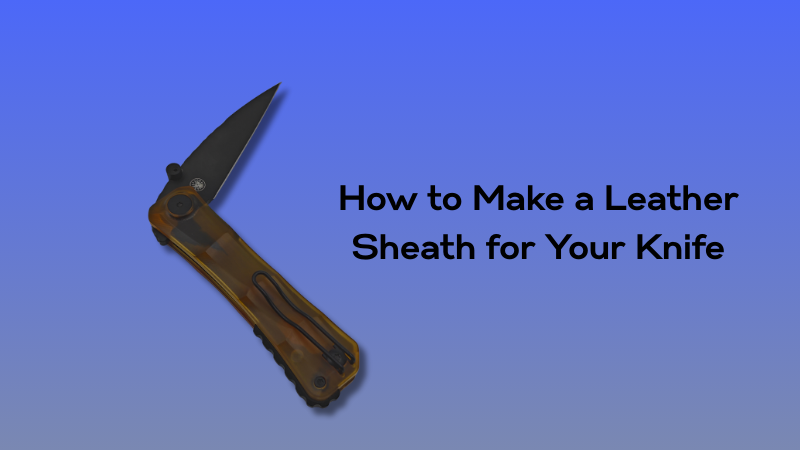
How to Make a Leather Sheath for Your Knife

Every knife, whether a Pocket knife, or a large hunting blade, fundamentally consists of two essential parts: the blade and the handle. These components work in unison, but when the knife isn’t in use,
proper storage becomes crucial, especially for fixed blades. Unlike folding knives, which tuck neatly into their handles, fixed blades demand a protective sheath.
At Shieldon, a brand rooted in decades of knife-making expertise, we know that a good sheath is not only about protection but also about enhancing the knife’s aesthetics and functionality. One of the most popular and traditional materials for knife sheaths is leather. Today, we’ll walk you through how to craft your very own leather sheath, its benefits, and why it’s a perfect match for a fine Shieldon knife.
Materials and Tools You'll Need
To make a durable leather sheath, gather the following materials:
· Heavy-duty leather (thicker, processed varieties preferred)
· Sharp rotary cutter or precision knife
· Pencil or marker
· Cardboard for templates
· Spring clips
· Masking tape
· A bowl of warm water
· Saran wrap
· Waxed thread for stitching
· Dishtowel
· Rowel wheel (for marking stitch lines)
· Groover tool (for carving stitching channels)
This list can be adapted based on your preferences. The goal is to create a sheath that complements your knife — making it unique and functional, just like a customized Shieldon EDC knife.
Step-by-Step: Crafting Your Leather Sheath
Step 1: Sketch the Pattern
Start by tracing your knife onto cardboard or directly onto the leather, leaving extra room around the blade. This ensures that the finished sheath has sufficient space to hold the knife without causing accidental cuts. If you’re making a sheath for a larger Martial Arts knife or a robust hunting knife, remember to account for the blade’s width and thickness.

Step 2: Cut Out the Leather
Use your rotary cutter to carefully cut along the outlined shape. After cutting, fold the leather over the knife to check the fit. It should wrap neatly around the blade, providing protection without being overly tight.

Step 3: Soften and Mold the Leather
Immerse the leather in warm water until bubbles stop rising, indicating it's fully soaked. Blot the leather gently with a dishtowel to remove excess water, then mold it around your knife. Secure it with spring clips, ensuring it forms a snug pocket. Keep adjusting every few minutes as it dries to maintain the desired shape.
Step 4: Trim the Sheath
With the leather partially dry and molded, trim the edges to create a smooth, clean outline. This helps the final sheath look professional and ensures the blade will slide in and out smoothly.
Step 5: Mark Stitch Lines
Use the groover tool to carve a stitching channel along the edge, then punch stitching holes with the rowel wheel or by hand. Aim for consistent spacing—about six holes per inch—for a neat and strong seam.
Step 6: Stitch the Sheath
Thread your waxed cord and sew the edges together firmly, using a saddle stitch technique. For maximum durability, double-stitch key stress points. Tie off the ends securely and lightly singe them with a lighter to prevent fraying.
Step 7: Final Fitting
Once stitched, slide your knife into the sheath to test the fit. If desired, add a loop for belt carrying or attach a lanyard for easier access. Your handmade leather sheath is now ready to accompany your adventures, whether you’re carrying a sturdy Shieldon hunting knife or a nimble folding EDC blade.

Why a Leather Sheath is Essential
While many folding knives, like a Shieldon Pocket knife, offer self-contained safety, fixed blades demand additional protection. A quality sheath provides multiple benefits:
· Safety First: Protects users from accidental cuts and shields others if you carry your knife openly.
· Blade Preservation: Shields the blade from moisture, dirt, and impact, prolonging its sharpness and lifespan.
· Enhanced Style: A finely crafted leather sheath adds a touch of class to any knife collection. Whether you own a rugged outdoors knife or an elegant Martial Arts knife, a custom sheath elevates its look.
· Secure Carrying: Prevents the knife from slipping or damaging your backpack or clothing.
Tips for Maintaining Your Leather Sheath
· Regularly treat the leather with oil or conditioner to maintain flexibility and prevent cracking.
· Keep the sheath dry whenever possible to avoid mold and rot.
· Periodically inspect the stitching and repair promptly if signs of wear appear.
· Avoid leaving your knife stored long-term in the sheath, as trapped moisture can damage even stainless blades over time.
Conclusion
A handcrafted leather sheath is more than just a protective cover — it’s an extension of your knife’s character. Creating one yourself adds a personal touch and ensures the best fit for your blade, whether it’s a Shieldon knife, a heavy-duty hunting knife, a classic Folding Knife, or an agile EDC knife.
At Shieldon, we combine traditional craftsmanship with cutting-edge technology to bring you the best knives and tools on the market. Explore our selection today and find the perfect companion blade—and perhaps the next sheath you'll be proud to craft yourself.
